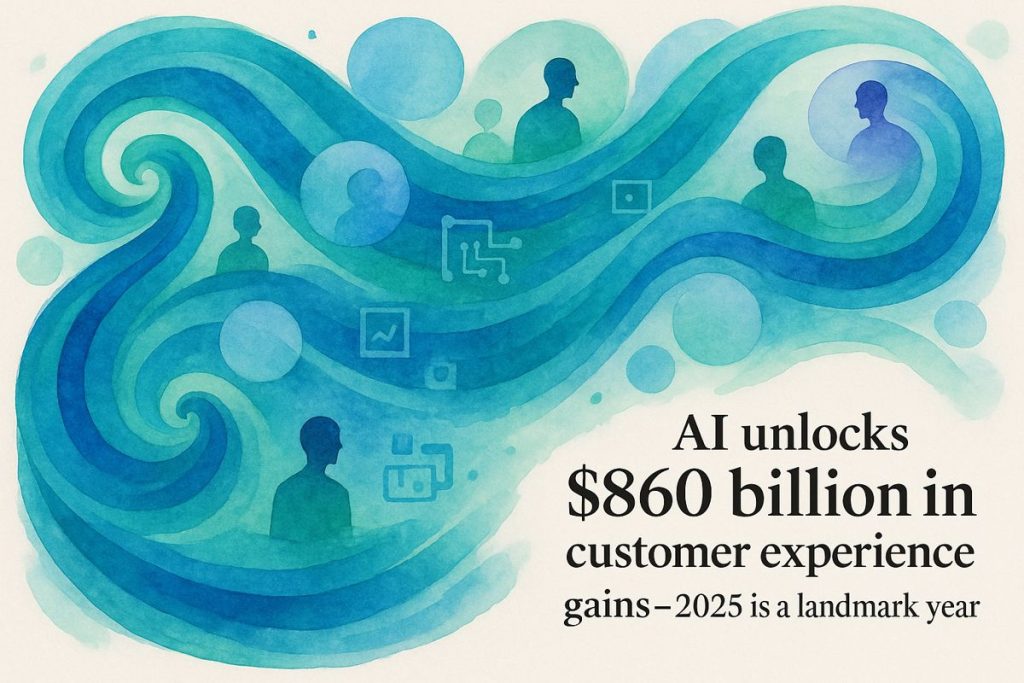There’s a huge $860 billion chance for companies to win big by using AI to make customer experiences better, according to Qualtrics’ 2025 research. With bad service costing businesses almost $4 trillion a year, smart companies are rushing to use new AI tools—like helpful virtual agents and super-flexible digital platforms—to keep customers happy and loyal. The latest tech even lets companies test ideas faster by mixing real and AI-made feedback, but human judgment still matters. In this AI-powered world, trust is super important, because even as companies get better at service, customers are quicker to leave if they feel let down.
What is the $860 billion AI opportunity in customer experience according to Qualtrics’ 2025 findings?
The $860 billion AI opportunity in customer experience refers to the global business value that companies can unlock by leveraging artificial intelligence for better customer interactions. Qualtrics’ 2025 research highlights AI-driven CX improvements as crucial for increasing loyalty, reducing churn, and preventing nearly $4 trillion in annual business losses due to poor experiences.
The Billion-Dollar Elephant in the Boardroom
Picture this: you’re sipping burnt office coffee, staring at a spreadsheet that’s more labyrinth than ledger, when suddenly the phrase “$860 billion global business opportunity in AI-driven customer experience” jumps out at you. I’ll be honest—my first reaction was a not-so-eloquent “wait, what?” That number is so large it feels like it ought to come with its own gravitational pull. But, as Qualtrics’ 2025 research repeatedly hammers home, this isn’t some hypothetical windfall—a real, tangible fortune is up for grabs for companies that get customer experience (CX) right with the help of artificial intelligence.
Here’s the kicker: nearly $4 trillion in global business is at risk every year due to crummy customer experiences. It’s as if the world’s collective patience is a brittle palimpsest, ready to flake away at the faintest whiff (yes, I said whiff—I can almost smell the burnt toast of missed opportunities) of bad service. The $860 billion figure, then, isn’t just a carrot—it’s a fire alarm.
SAP and Salesforce, those twin titans of enterprise software, have been quick to saturate their offerings with AI tools that go beyond mere automation. This isn’t about replacing humans with soulless chatbots; it’s more akin to giving your best customer service rep a hyperspectral lens so they can spot a brewing issue before it fogs the glass. And yet, I had to stop and ask myself: are organizations really ready to seize this? Or are most of us still muddling through, treating CX as an afterthought? (Spoiler: too many are still muddling.)
Experience Agents, Metamorphosis, and the Hum of Progress
Let’s zoom in. Qualtrics’ X4 Summit this year felt more like a science fair for grown-ups than your garden-variety corporate shindig. The star of the show? “Experience Agents”—AI-powered virtual helpers designed to glide through billions of customer and employee touchpoints. They’re less like the clunky IVRs of yesteryear and more like shape-shifting polyglots, handling issues before they become complaints. Frankly, the first time I saw one in action, I felt a pang of envy—not for the tech, but for the customers who’ll never have to navigate a telephone maze again. Bam! Instant support.
Platforms are evolving, too. SAP’s composable CX suite is a prime example—a sort of digital LEGO set where you can snap together AI-driven personalization, data unification, and orchestration tools as needed. This kind of modularity lets you pivot on a dime, whether you’re in pharma, retail, or some niche sector whose acronym I haven’t yet memorized. (I once tried to cram all of SAP’s product names into a single sentence. The result? A tongue-twister that even Dostoyevsky would envy.)
Salesforce and SAP S/4HANA Cloud aren’t just playing catch-up, either. They’re integrating these AI smarts so deeply into their ecosystems that the boundary between “tool” and “strategy” gets deliciously blurred.
And yet, there’s always that moment—a little flicker of uncertainty—when I wonder if all this composability might tempt some execs to endlessly tinker, Lego-style, without ever finishing the castle. Analysis-paralysis, meet your new best friend.
Synthetic Research: Peering Beyond the Looking Glass
Now, here’s where it all gets a little bit “Alice in Wonderland.” Qualtrics’ new “Edge” platform blends old-school surveys with synthetic, AI-generated audiences. Instead of wrangling a panel of humans for feedback, you can now conjure up synthetic personas—sort of like anthropological shadow puppets, minus the string. I’ll confess, my first reaction was skepticism. Could an algorithm really simulate the nuanced, kaleidoscopic opinions of a B2B buyer in Luxembourg or a Gen Z sneakerhead in Seoul?
But the numbers spoke louder than my doubts. With this hybrid approach, companies are slicing months off their research cycles (Forrester analysis here). And, as I learned the hard way during an ill-fated focus group (the one with the malfunctioning air conditioner and the angry vegan snacks), sometimes speed and breadth matter just as much as depth.
Of course, there’s a catch—there’s always a catch. AI-generated insights aren’t a silver bullet. Without the grounding of real-world data, even the savviest algorithms can hallucinate, spinning fables out of statistical noise. I felt a twinge of anxiety just thinking about it, but it underlines a broader truth: synthetic research is a tool, not a replacement for human intuition or empirical grit.
Trust, Loyalty, and the Delicate Dance of Data
If AI in CX is the orchestra, then trust is the conductor—without it, you’ve just got a cacophony. As AI-driven platforms proliferate, Qualtrics’ latest trends report points to something that feels almost paradoxical: negative customer experiences are statistically on the decline, but loyalty is eroding faster than my resolve on a Monday morning.
It’s a strange sensation, like hearing a familiar melody played in a minor key
